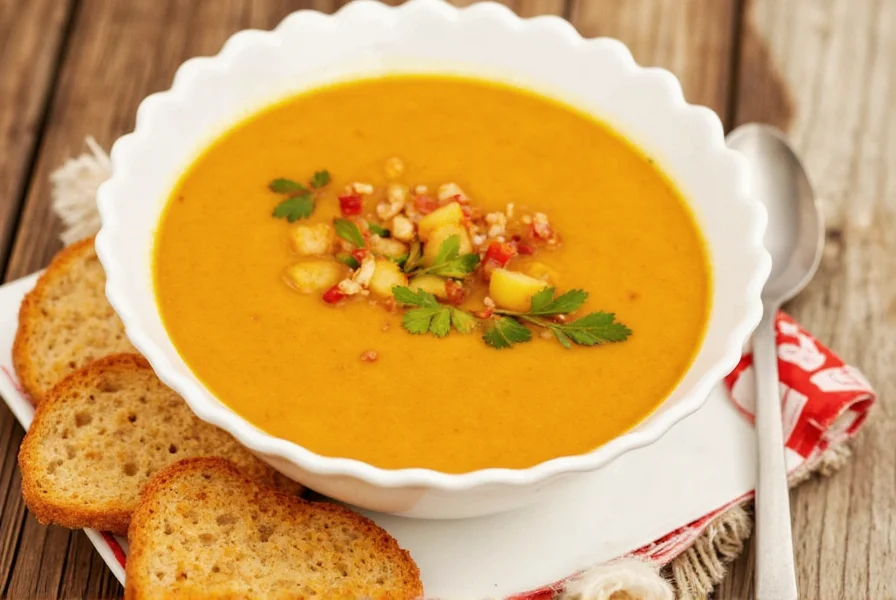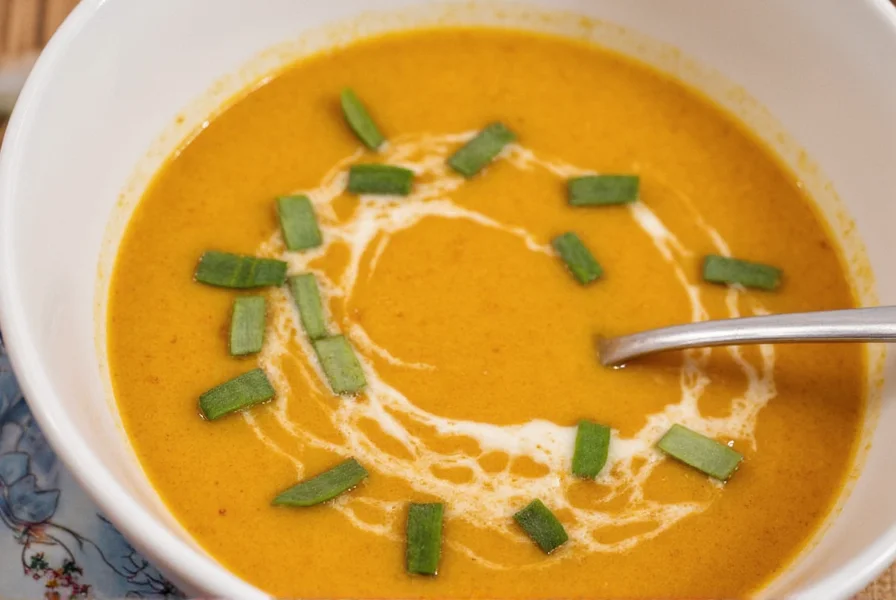Table of Contents
Apple squash soup is a comforting and flavorful dish that blends the sweetness of apples with the earthiness of squash. It's a perfect meal for fall and winter, offering warmth and nutrition in every spoonful. But what if you want to take it up a notch? Enter the world of spices—where a simple soup can transform into an exciting culinary experience.

This article will guide you through the basics of spice, how to enhance your apple squash soup with different flavor profiles, and provide practical tips for both beginners and seasoned cooks. Whether you're a spice enthusiast or just looking to experiment, this guide has something for everyone.
Spice Basics: What You Need to Know
Before we dive into the nitty-gritty of spicing up your apple squash soup, let's take a quick look at the fundamentals of spices. Understanding the different types and their uses can help you make informed choices and avoid over-seasoning.
Common Spices Used in Cooking
- Cinnamon: Adds warmth and sweetness, perfect for apple-based dishes.
- Ginger: Brings a zesty kick and enhances the natural flavors of the soup.
- Allspice: Offers a complex, peppery flavor that complements both sweet and savory elements.
- Nutmeg: Provides a subtle, nutty aroma and depth of flavor.
- Cumin: Adds an earthy, smoky note that can be great in a more adventurous version of the soup.
| Spice | Flavor Profile | Best Use in Apple Squash Soup |
|---|---|---|
| Cinnamon | Warm, sweet, aromatic | Enhances natural sweetness of apples |
| Ginger | Zesty, bright, slightly spicy | Boosts complexity without overpowering |
| Allspice | Peppery-sweet, complex | Creates harmony between sweet and savory |
| Nutmeg | Nutty, warm, subtle | Adds depth without dominating |
| Cumin | Earthy, smoky, robust | For savory-leaning variations |
How Spices Work in Cooking
Spices are not just about heat—they add layers of flavor, aroma, and texture. When used correctly, they can elevate a simple dish into something extraordinary. For example, adding a pinch of cinnamon to your apple squash soup can make it taste like a cozy autumn morning.
However, it's important to remember that less is often more. Start with small amounts and adjust as needed. Over-spicing can overpower the natural flavors of the ingredients, especially in delicate dishes like soups.
Practical Tips for Making Apple Squash Soup
Now that you understand the basics, here are some practical tips to help you create a delicious and well-balanced apple squash soup:
Tip 1: Choose the Right Apples and Squash
The quality of your ingredients plays a big role in the final outcome. For apples, choose varieties like Honeycrisp or Granny Smith for a good balance of sweetness and tartness. For squash, butternut or acorn squash are excellent choices due to their rich, creamy texture.

Tip 2: Roast the Vegetables for Depth of Flavor
Roasting your squash and apples before blending them adds a caramelized layer of flavor that makes the soup more robust. Simply toss the chopped vegetables with olive oil, salt, and pepper, then roast at 400°F (200°C) for about 30–40 minutes until tender and golden.
Tip 3: Use Fresh Herbs and Spices
Fresh herbs like thyme or rosemary can add a fragrant touch, while freshly ground spices ensure maximum flavor. Avoid pre-ground spices, as they tend to lose potency over time.
Tip 4: Balance Sweet and Savory Flavors
Apple squash soup has a naturally sweet profile, so it's essential to balance it with some savory elements. Adding a splash of cream, a dash of soy sauce, or even a bit of miso can give the soup a more rounded and complex flavor.

Tip 5: Experiment with Spice Combinations
Don't be afraid to get creative! Try adding a pinch of cumin or a hint of smoked paprika for a unique twist. Or, go all out with a blend of cinnamon, nutmeg, and clove for a warm, spiced version that feels like a holiday treat.
Buying Guide: Choosing the Right Ingredients
To make the best apple squash soup, it's crucial to select high-quality ingredients. Here's a detailed buying guide to help you choose the right products:
Apples
- Best for: Sweetness and tartness balance
- Recommended Varieties: Honeycrisp, Granny Smith, Braeburn
- Use Cases: Soups, pies, sauces
- Target Audience: Home cooks, bakers, chefs
- Suitable Occasions: Fall and winter meals, holiday gatherings
Squash
- Best for: Creamy texture and earthy flavor
- Recommended Varieties: Butternut, Acorn, Delicata
- Use Cases: Soups, roasts, purees
- Target Audience: Health-conscious individuals, plant-based eaters
- Suitable Occasions: Comfort meals, seasonal cooking
Spices
- Best for: Flavor enhancement and complexity
- Recommended Spices: Cinnamon, Nutmeg, Cumin, Ginger
- Use Cases: Seasoning, baking, savory dishes
- Target Audience: Spices enthusiasts, home cooks
- Suitable Occasions: Everyday meals, special occasions

When shopping, look for fresh, firm produce without bruises or soft spots. For spices, opt for whole spices whenever possible and grind them yourself for the best results. Store your ingredients properly to maintain their quality and extend their shelf life.
Frequently Asked Questions
What are the 5 essential spices for perfect apple squash soup?
The five essential spices for apple squash soup are cinnamon, nutmeg, ginger, allspice, and cumin. Cinnamon adds warmth and sweetness that complements the apples, nutmeg provides a subtle nutty depth, ginger brings a bright zesty note, allspice offers complex peppery-sweet notes, and cumin adds an earthy dimension for those who enjoy a more savory profile. Start with small amounts (⅛ to ¼ teaspoon per spice for a standard batch) and adjust to taste.
Can I make apple squash soup without certain spices if I have allergies or preferences?
Absolutely. The beauty of apple squash soup is its versatility. If you need to avoid certain spices due to allergies or personal preferences, you can easily substitute or omit them. For example, if you don't like cumin's earthy flavor, you could increase the ginger or add a pinch of cardamom instead. The soup will still be delicious with just cinnamon and nutmeg as your primary spices. Remember that the squash and apples themselves provide wonderful natural flavors that shine through even with minimal seasoning.
How do I balance the sweetness of apples with savory spices in the soup?
Balancing sweet and savory elements is key to a well-rounded apple squash soup. If your soup tastes too sweet, add a splash of apple cider vinegar, lemon juice, or a dash of soy sauce to introduce acidity and umami. For a more savory profile, increase spices like cumin or add a pinch of smoked paprika. Salt is also crucial—it enhances all flavors and helps balance sweetness. Start with ¼ teaspoon of salt, then taste and adjust. Remember to season in layers: add some spices when roasting vegetables, more when sautéing aromatics, and finish with a final adjustment before serving.
What's the best way to incorporate spices into apple squash soup?
For maximum flavor impact, use spices at different stages of cooking. Add hardy spices like cumin and coriander to the oil when sautéing onions or aromatics to "bloom" their flavors. Add delicate spices like cinnamon and nutmeg toward the end of cooking to preserve their nuanced aromas. If using whole spices, toast them briefly in a dry pan before grinding. For roasted vegetable soups like apple squash, you can also toss spices with the vegetables before roasting—this creates a beautiful caramelized flavor base. Always remember to taste and adjust seasoning at the end, as flavors concentrate during cooking.
Can I make this soup vegan or dairy-free?
Yes, apple squash soup can easily be made vegan or dairy-free. Simply omit any dairy cream and instead use coconut milk, cashew cream, or a splash of unsweetened almond milk for creaminess. The natural creaminess of butternut squash often provides enough body that additional cream isn't even necessary. For extra richness, blend in a small amount of soaked cashews or silken tofu. To enhance the "creamy" mouthfeel without dairy, try adding a tablespoon of tahini or almond butter near the end of cooking.
How should I store and reheat apple squash soup to maintain flavor?
Apple squash soup stores well in the refrigerator for 4-5 days in an airtight container. For best flavor retention, cool the soup quickly after cooking and store it without garnishes. When reheating, do so gently over medium-low heat to preserve the delicate spice flavors—high heat can cause spices to become bitter. Stir occasionally and add a splash of water or broth if the soup has thickened too much. Interestingly, the flavors often meld and improve overnight, with spices becoming more integrated. For freezing, store in portion-sized containers for up to 3 months; thaw in the refrigerator overnight before reheating.
Conclusion
Apple squash soup is a versatile and delicious dish that can be easily elevated with the right spices. By understanding the basics of seasoning and experimenting with different flavor combinations, you can create a soup that's uniquely yours. Whether you're a seasoned cook or just starting out, there's always room to explore and innovate in the kitchen.
So next time you're making apple squash soup, don't forget to think about the spices. They can transform a simple bowl of soup into a memorable dining experience. Remember, the key is to balance the flavors and enjoy the process—after all, cooking should be fun!

With these tips and guidance, you're now equipped to make a mouthwatering apple squash soup that's both comforting and full of flavor. Happy cooking!











 浙公网安备
33010002000092号
浙公网安备
33010002000092号 浙B2-20120091-4
浙B2-20120091-4